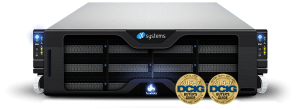The storage industry was once dominated by Direct-Attached Storage or DAS for short, which is little more than a given number of disks attached to a computer. By contrast, modern storage includes key software and network layers that all contribute to the definition of “Software-Defined Storage”. These layers of software and networking reside between the raw storage devices and users, providing any number of features from standard sharing protocols and powerful management features. Where we hear “SDS” most used, however, is in regards to something rather specific: Hardware-Agnostic Storage
Hardware-agnostic or hardware-decoupled storage refers to the isolation of all these new software and network layers from the hardware they run on. Take for example our FreeNAS storage operating system: It combines the FreeBSD Operating System, the OpenZFS enterprise file system, industry-standard file and block sharing protocols and a web management interface to create an easy-to-use storage solution that runs on nearly any Intel-based system. With over 8.5 million FreeNAS downloads, we are more than happy to accept the title for the “World’s #1 Software-Defined Storage” solution, but doing so does not clear up all the confusion around “SDS”. FreeNAS is free of charge and you are indeed free to run it on whatever hardware you like, but that’s not actually what the “Free” in its name refers to: The “Free” refers to the freedom that a fully Open Source storage solution provides you, from the available source code to its freedom from artificial constraints like a maximum capacity. People can, and do build multi-Petabyte FreeNAS systems and we would never prevent them from doing so.
But that’s not the point.
Our success with FreeNAS continuously reminds us of one simple fact: Software is only one piece of a storage solution. The quality of the system that runs your storage software and the storage hardware devices that perform the actual heavy lifting can be just as critical, if not more critical, than the storage software itself. The same is true, if not more so in virtualized environments where the communication of the OpenZFS file system we use with the underlying disks is critical to verifiable data integrity. You are free to run FreeNAS on whatever hardware you like but we have engineered hardware to precisely meet the requirements of the FreeNAS software, as represented by the FreeNAS Mini and FreeNAS Certified lines.
But even that’s not the point.
FreeNAS on FreeNAS Certified hardware is something we take great pride in but great software on great hardware does not necessarily unlock the full potential of one another. We could have stopped here, as many “SDS” vendors do, but we recognized the potential for creating something that is greater than the sum of its parts. The result is TrueNAS, our Enterprise-class, Highly Available storage platform. TrueNAS employs a tightly-integrated, hot-swappable modular design with the features needed to help guarantee the integrity and availability of mission-critical data. Unlike FreeNAS on FreeNAS Certified hardware, or most SDS solutions for that matter, TrueNAS offers:
- Toolless/Modular 3U Rack Mount
- Hot-Swappable Storage Controllers with no single point of failure
- Global Fault Notification Indicator Light
- Enclosure Management Services, Hardware Alerts, and Drive Fault Notification
- VMware, Citrix and Microsoft certifications and integration
- Racking and Deployment Services
- Performance Tuning by our Engineers
- Up to 24/7 Hardware and Software Support
- Integrated Proactive Support, Support Portal and Monitoring
- Optional High Availability Failover with Zero-Downtime Software Upgrades
- Optional Zero-Downtime Controller Upgrades
- Optional Expansion Cabinets for up to 4PB of RAW Capacity
- Optional Fiber Channel Connectivity

Of these TrueNAS-only features, Support probably doesn’t stand out, but we encourage you to contemplate the “Support” you receive with a Hardware-Agnostic Storage solution. Which of the two or more vendors do you turn to first? How can you guarantee that your separate hardware and software vendors will not engage in finger pointing or a circular blame game? With TrueNAS, the buck stops here, and that’s even true before it reaches you: TrueNAS is designed and built by our US-based engineering team at our Silicon Valley-based headquarters. Our engineering, manufacturing, sales and support staff all work closely to guarantee you a one-stop, authoritative answer to any question you have at any stage in the relationship.
The à la carte Storage Pitfalls
We won the hardware-agnostic SDS game with FreeNAS but if you are procuring a storage system for your mission-critical data, ask the competition these simple questions:
- Am I truly free to run your “SDS” solution on any hardware I want, or only select pre-certified systems?
- Must I be concerned with minute hardware details like firmware versions of individual components?
- How will you guarantee that my performance requirements are met?
- Will I actually save money by paying a separate software license fee on top of my hardware costs?
- Will I need to pay additional license fees to unlock features?
- Will the software notify me of and locate hardware faults?
- Can I upgrade my software and hardware together as my needs grow?
- Can I replace the hardware or software vendor as my needs change?
- Who do I turn to first if I have a question or issue?
- Can you guarantee that you will take full responsibility for my issue?
- Can you guarantee me a fast, coordinated resolution while I could be losing money due to downtime?
Before considering Software-Defined Storage, consider iXsystems TrueNAS Clearly-Defined Storage and learn just how important tight hardware integration is in enterprise-class storage.
Michael Dexter
Senior Analyst